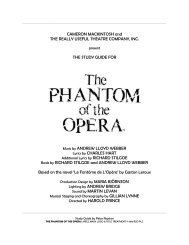Educational Guide - Memphis the Musical
Educational Guide - Memphis the Musical
Educational Guide - Memphis the Musical
Create successful ePaper yourself
Turn your PDF publications into a flip-book with our unique Google optimized e-Paper software.
Before <strong>the</strong> Show<br />
Extension Activity:<br />
Exploring The<br />
Great Migration<br />
through Literature<br />
Many strong literary works came out in<br />
response to The Great Migration. Find a<br />
literary work like Langston Hughes’ poem,<br />
“The South,” to share with your class. After<br />
having read <strong>the</strong> work, ask your students<br />
<strong>the</strong> following questions:<br />
1.What does <strong>the</strong> work reveal about life<br />
in <strong>the</strong> South In <strong>the</strong> North<br />
2.How does <strong>the</strong> writer feel about The<br />
Great Migration<br />
3.Is <strong>the</strong>re a solution <strong>the</strong> writer is suggesting<br />
4.What do you think black migrants<br />
found once <strong>the</strong>y moved to <strong>the</strong> North<br />
What aspects of life were better, worse,<br />
and/or <strong>the</strong> same<br />
National Standards for Learning: NSS-<br />
USH.9-12.9: Era 9: Postwar United<br />
States, NL-ENG.K-12.5: Communication<br />
Strategies, NL-ENG.K-12.9: Multicultural<br />
Understanding, NL-ENG.K-12.11: Participating<br />
in Society<br />
New York City Department of Education’s<br />
Blueprint for Teaching and Learning in <strong>the</strong><br />
Arts: BP-T.9-12.3: Making Connections<br />
The Great<br />
Migration<br />
Read <strong>the</strong> following article aloud to your class to provide your students<br />
with relevant historical background information. Have <strong>the</strong>m<br />
complete <strong>the</strong> suggested extension activity to stimulate fur<strong>the</strong>r<br />
discussion. (Note: The Great Migration becomes a focal point of<br />
<strong>Memphis</strong>, as <strong>the</strong> characters look to move North for <strong>the</strong> prospect<br />
of living without segregation and for career advancement.)<br />
In <strong>the</strong> wake of extreme adversity in <strong>the</strong> South,<br />
many black people viewed <strong>the</strong> North as <strong>the</strong> “promised land.” The Jim<br />
Crow Laws designating that public facilities, schools and transportation<br />
be separate, paired with <strong>the</strong> violence of <strong>the</strong> Ku Klux Klan, generated<br />
great fear and uncertainty amongst <strong>the</strong> black community.<br />
The Great Migration was a movement that spanned from 1910–<br />
1970, which resulted in a surge of six and a half million black migrants<br />
moving from <strong>the</strong> South to <strong>the</strong> North. In fact, in 1910 <strong>the</strong>re was 80%<br />
of <strong>the</strong> black population living in <strong>the</strong> South, while <strong>the</strong>re only remained<br />
25% by 1970. Popular destinations in <strong>the</strong> North were major cities<br />
such as New York City, Chicago and Philadelphia. This was largely<br />
due to <strong>the</strong> need for factory workers in <strong>the</strong> Industrial North, and <strong>the</strong><br />
rumor that black workers could earn three times as much compared<br />
to <strong>the</strong>ir jobs in <strong>the</strong> South.<br />
While segregation was not legal in <strong>the</strong> North, it still presented a<br />
wide range of challenges for black migrants. Prejudice and racism<br />
still existed (often referred to as “de facto segregation”), while blacks<br />
frequently had to face poor living conditions and dangerous work<br />
environments.<br />
© Chris Owyoung 2009<br />
10 • w w w. memphis<strong>the</strong>music a l . c o m





